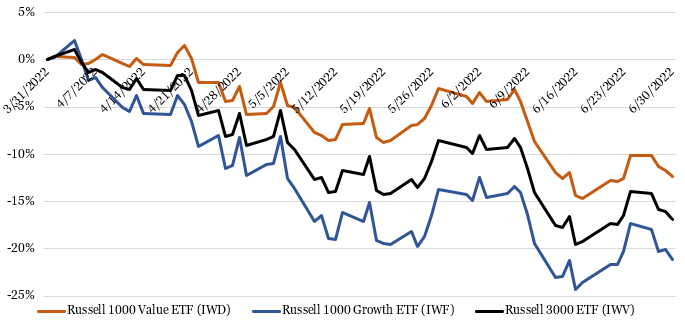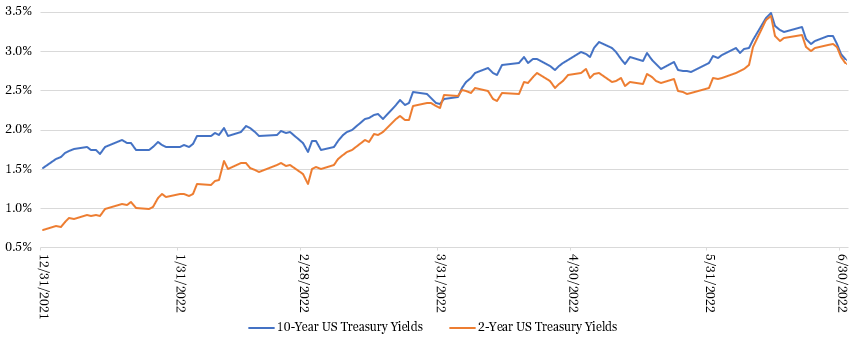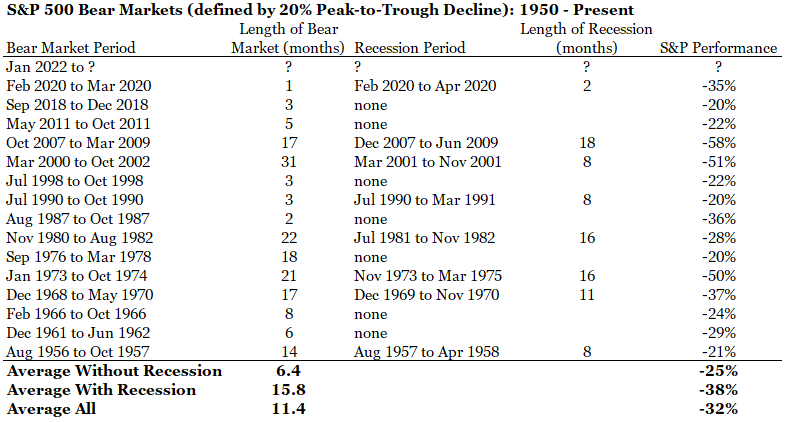July 2022 Investment Letter
July 3, 2022
A persistent selloff has the stock market officially in a bear market, defined as at least 20% off highs. In the second quarter the iShares Russell 3000 ETF (ticker IWV), a broad measure of market performance, declined 17%. That pushed the year-to-date decline to 21%, slightly off the maximum drawdown of 24% on June 16.
Other oft-cited stock market benchmarks had similarly tough starts to the year. The S&P 500 (largest 500 stocks by market capitalization), Dow Jones Industrial Average (price-weighted index of 30 stocks), Nasdaq Composite (mostly comprised of technology and growth stocks), and Russell 2000 (small capitalization stocks) were down 21%, 15%, 30%, and 24%, respectively, over the past six months. It was the worst first half of the year since 1950 for the S&P 500, worst since 1962 for the Dow, and ever for the Nasdaq and Russell 2000. Even the bond market performed poorly, with the Bloomberg U.S. Agg, a broad index of fixed-income securities, down 11%. That is also its worst first half based on data going back to 1975.
Like the preceding quarter, value stocks declined less than growth stocks in the second quarter as the Federal Reserve took a more aggressive approach to attack persistently high inflation by signaling greater rate hikes. Higher interest rates particularly impact growth stocks because growth stocks have a greater proportion of expected earnings further into the future. Those more distant earnings are worth less today when interest rates are higher. By contrast, value stocks tend to hold up relatively well with utilities and consumer staples acting as safe havens in times of greater uncertainty. This past quarter also saw energy stocks soar alongside spiking crude oil and natural gas prices.
Figure 1: The Stock Market Had a Terrible Second Quarter, Especially Growth Stocks
Source: Yahoo Finance (inclusive of dividends)
Inflationary concerns are quickly being overtaken by recessionary fears as the number one market worry. The shifting landscape can be best illustrated by the dramatic rise and fall of U.S. Treasury yields recently, especially the 2-year Treasury yield, the maturity most attuned to future Fed moves. The 2-year yield spiked in anticipation of and following the Fed’s June 15 announcement to raise the Fed Funds rate by a greater-than-signaled 75 basis points, or 0.75%, to 1.50-1.75%. Since then, there have been growing concerns that the Fed’s tough stance on inflation, which has come much too late, will force an economic hard landing. The 2-year yield has retreated over 60 basis points from its 3.45% closing high on June 14, a sign the Fed will eventually have to curtail rate increases to save a faltering economy.
Figure 2: June’s Rise and Fall of U.S. Treasury Yields Reflects Shifting Concerns from Inflation to Recession
Source: St. Louis Fed/Board of Governors of the Federal Reserve System. https://fred.stlouisfed.org/series/DGS2. https://fred.stlouisfed.org/series/DGS10
Market Outlook
There are various ways to gauge future market performance after such an awful first half of the year – some are encouraging, others less so.
An optimistic take arises from a simple analysis of how the market does after a poor first half of the year. According to the Wall Street Journal, the S&P 500 has risen an average of 24% in the second half of the year when it declined at least 15% in the first half, as it did in 1932, 1939, 1940, 1962 and 1970.
Depending on one’s view of recession likelihood, an alternative analysis of looking at past bear markets – again, when the market is already down at least 20% -- might paint a less rosy picture. As Figure 3 illustrates, in instances with no recession, stocks on average bottom after six months of declines that total 25%. In times of recession, stocks on average bottom after 16 months of declines that total 38%. Worth noting is that these figures exclude recessions that do not produce bear markets – overall the S&P 500 fell a median 24% during recessions according to figures dating to 1946.
Figure 3: S&P 500 Bear Markets (defined by 20% peak-to-trough decline): 1950 - Present
Sources: National Bureau of Economic Research, Compound Advisors. https://compoundadvisors.com/2022/every-bear-market-is-different
The bear market analysis begs the question of recession likelihood and severity. We believe it will be very difficult for the Fed to orchestrate a “soft landing” and avoid a recession because of the Fed’s 12 previous big tightening cycles since the 1950s, nine ended with a recession. We believe there is approximately 80% odds of a recession by early 2023 (if we are not already in one), with a 35% probability of a mild recession, 35% chance of a moderate recession, and 10% risk of a severe recession. This compares to a Wall Street Journal survey of economists in June that saw a 44% probability of recession in the next 12 months.
If there’s just a mild recession or no recession at all, then we think the stock market is very close to a bottom as the market has already discounted a fair amount of growth deceleration. If there is a moderate recession, then we could see scope for another 10-20% decline, bringing the total market decline to around one third. In the unlikely event we experience a severe recession, ala 2008, then we could see another 25%-33% plunge. We find this scenario the least plausible because consumer and corporate balance sheets are healthy, and the financial system is operating well outside of the cryptocurrency ecosystem.
Besides an economy that proves to hold up relatively well, an important catalyst to a better performing stock market will be when the Fed first signals it is done raising rates. We expect the Fed to become less enamored in aggressively raising rates in the months ahead as the Fed’s preferred inflation gauge -- PCE -- trends down from its 6.3% rate in May (May CPI inflation was 8.6%) and the economy definitively weakens. We believe the Fed will be finished raising rates by early 2023 and will be considering rate cuts a year from now, much earlier than the market expects.
Client Positioning
We take a long-term view that focuses on compounding returns in a tax-efficient manner. We allocate the bulk of our clients’ equity exposure into “quality growth” companies that have durable competitive advantages, above-average long-term growth prospects, high levels of profitability and free cash flows, and prudent levels of debt. We generally take a “pruning the weeds and nurturing the flowers” approach of selling stocks that violate our investment thesis and retaining stocks that execute well. We believe this investment philosophy affords our clients the best shot of generating maximum after-tax, risk-adjusted returns compounded over the long run.
We made a greater-than-usual number of changes to client portfolios in the second quarter to address the rapidly changing economic environment and take advantage of some attractive buying opportunities. The changes reflect a somewhat more defensive posture, with our reducing exposure to aggressive growth and highly economically sensitive companies. There remains a growth bias in the portfolio, so clients should expect their equity portfolio to do best versus the market when inflation is low or decelerating and 10-year treasury yields are low or declining.
We believe a turning point for growth outperformance could soon be upon us, at least for those companies with manageable sensitivity to the economy. Our call for a much-weakened economy, easing inflationary pressures, and a less hawkish Fed should allow treasury yields to stay tame and allow valuation multiples to expand again, even if declining earnings estimates act as a counterweight to stock prices. In that environment we would expect consumer staples, healthcare, real estate, utility, and some areas of the technology sectors to outperform, and consumer discretionary, financials (mainly banks), industrials, energy, and basic materials sectors to underperform.
Figure 4: Portfolio Changes in Majority of Client Accounts in 2Q 2022
Source: Glass Lake Wealth Management
You are unlikely to see us chase stocks in the hot oil & gas sector. Although oil and natural gas prices are currently supported by export sanctions on Russia, the industry is notorious for going through boom-and-bust cycles. We want to avoid the painful part of the cycle, which could be sooner than expected if the global economy dramatically weakens or energy export sanctions on Russia are softened because nations’ economic pain thresholds have been crossed or President Putin is somehow no longer in power.
You can also expect us to abstain from the most speculative areas of the market, such as unprofitable IPOs, SPACs, cryptocurrency plays, and meme stocks. As always, we will keep an open mind and be on the hunt for the next great long-term investment.
Outside of equities, we made changes to client portfolios that carry fixed income allocations. We sold our high yield corporate bond positions due to our concerns that default rates could spike in a moderate to severe recession scenario. We also rid portfolios of short maturity corporate bonds because of their relatively low yields. In their place we purchased one- and two-year U.S. treasuries when their yield-to-maturities spiked to above 3% in mid-June. These ultra-safe securities provide some ballast to client portfolios and can be redirected to higher yielding securities when the economic outlook improves.
We hope you and your loved ones stay happy, healthy, and wealthy and are enjoying the summer.
Sincerely,
Jim Krapfel, CFA, CFP
Founder/President
Glass Lake Wealth Management, LLC
glasslakewealth.com
608-347-5558
Disclaimer
Advisory services are offered by Glass Lake Wealth Management LLC, a Registered Investment Advisor in the State of Illinois. Glass Lake is an investments-oriented boutique that offers a wide spectrum of wealth management advice. Visit glasslakewealth.com for more information.
This investment letter expresses the views of the author as of the date indicated and such views are subject to change without notice. Glass Lake has no duty or obligation to update the information contained herein. Further, Glass Lake makes no representation, and it should not be assumed, that past investment performance is an indication of future results. Moreover, whenever there is the potential for profit there is also the possibility of loss.
This investment letter is being made available for educational purposes only and should not be used for any other purpose. The information contained herein does not constitute and should not be construed as an offering of advisory, legal, or accounting services or an offer to sell or solicitation to buy any securities or related financial instruments in any jurisdiction. Certain information contained herein concerning economic trends or market statistics is based on or derived from information provided by independent third-party sources. Glass Lake Wealth Management believes that the sources from which such information has been obtained are reliable; however, it cannot guarantee the accuracy of such information and has not independently verified the accuracy or completeness of such information or the assumptions in which such information is based.






